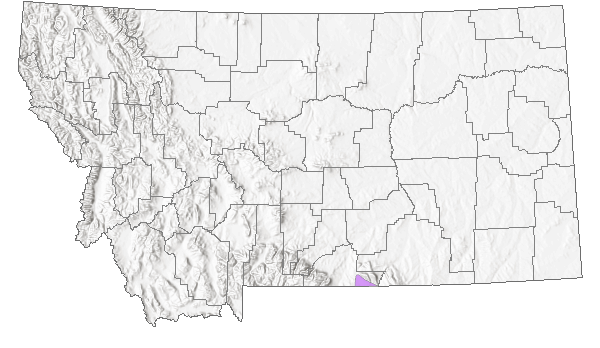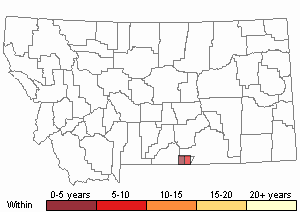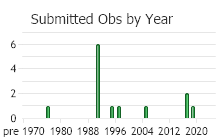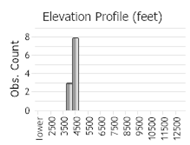View in other NatureServe Network Field Guides
NatureServe
Montana
Utah
Wyoming
Idaho
Wisconsin
British Columbia
South Carolina
Yukon
California
New York
Desert Dandelion - Malacothrix torreyi
State Rank Reason (see State Rank above)
Desert dandelion is limited in Montana to a few localized sites on the south side of the Pryor Mountains. Impacts of grazing are unknown, but it may respond positively to moderate levels of disturbance. Additional data on population levels and trends are needed.
General Description
Desert Dandelion is a taprooted annual with milky sap and a basal rosette of leaves giving rise to one to several erect or ascending stems that are 1-3 dm high. The basal leaves are up to 10 cm long, have petioles, and are deeply pinnately divided into toothed and pointed lobes. The few stem leaves are reduced upwardly. The foliage has sparse long hair when young but is glabrous with age, other than the sparse, glandular hairs in the inflorescence. The several stalked flower heads arise from reduced upper leaves, or bracts, in an open inflorescence. Flower heads nod in the bud but become erect in flower. Each is 8-13 mm high with 2 series of involucral bracts, the outer of which is very short, and the inner of which is long-pointed. Rays are yellow and ca. 1 cm long, and disk flowers are lacking. The cylindrical achenes are 5-ribbed, 3-4 mm long, and topped by a pappus of numerous unbranched, white bristles that are united at the base and fall as one when seeds mature.
Phenology
Flowering takes place in June.
Diagnostic Characteristics
Several genera have yellow dandelion-like flower heads on leafy stems. Species of Hieracium differ in that they are perennial and have leaves with entire or shallowly lobed margins. The genus Lactuca has involucral bracts in more than two series and Sonchus has clasping stem leaves. Species of Crepis are perennial or have shallowly lobed leaves.
Species Range
Montana Range
Range Descriptions

 Native
Native
Range Comments
WY, eastcentral ID, and southcentral MT to southeast OR, south to AZ, NV, and possibly CA. Disjunct.
Observations in Montana Natural Heritage Program Database
Number of Observations: 15
(Click on the following maps and charts to see full sized version)
Map Help and Descriptions
Relative Density

Recency



 (Observations spanning multiple months or years are excluded from time charts)
(Observations spanning multiple months or years are excluded from time charts)
Habitat
Desert dandelion occurs locally below 1525 m (5000 feet) on the south side of the Pryor Mountains (Lesica and Achuff 1992). Information from the few known occurrences suggests that it prefers sandy alluvium, often occurring with Artemisia tridentata, Atriplex gardneri, Astragalus geyeri and Bouteloua gracilis.
Ecology
This species is an annual, suggesting that population sizes may vary greatly between years. The low stature and annual habit also suggest that it may suffer from competition with larger plants, may require sparse vegetation and could respond positively to moderate levels of disturbance (Lesica and Achuff 1992).
Management
Populations are subject to grazing, but the effects are unknown. Grazing removes the palatable, more competitive grasses and may favor species like M. torreyi. However, many species in the Tribe Lactuceae are palatable to ungulates.
Stewardship Responsibility
Threats or Limiting Factors
STATE THREAT SCORE REASON
Threat impact not assigned because threats are not known (MTNHP Threat Assessment 2021).
References
- Literature Cited AboveLegend:
 View Online Publication
View Online Publication Lesica, P., M.T. Lavin, and P.F. Stickney. 2012. Manual of Montana Vascular Plants. Fort Worth, TX: BRIT Press. viii + 771 p.
Lesica, P., M.T. Lavin, and P.F. Stickney. 2012. Manual of Montana Vascular Plants. Fort Worth, TX: BRIT Press. viii + 771 p. MTNHP Threat Assessment. 2021. State Threat Score Assignment and Assessment of Reported Threats from 2006 to 2021 for State-listed Vascular Plants. Botany Program, Montana Natural Heritage Program, Helena, Montana.
MTNHP Threat Assessment. 2021. State Threat Score Assignment and Assessment of Reported Threats from 2006 to 2021 for State-listed Vascular Plants. Botany Program, Montana Natural Heritage Program, Helena, Montana.
- Additional ReferencesLegend:
 View Online Publication
View Online Publication
Do you know of a citation we're missing? Davis, W.S. 1986. Reproductive biology of Malacothrix (Asteraceae). American Journal of Botany. 73:758-759.
Davis, W.S. 1986. Reproductive biology of Malacothrix (Asteraceae). American Journal of Botany. 73:758-759. Lesica, P. and P.L. Achuff. 1992. Distribution of vascular plant species of special concern and limited distribution in the Pryor Mountain desert, Carbon County, Montana. Unpublished report to the Bureau of Land Management. Montana Natural Heritage Program, Helena, MT. 105 pp.
Lesica, P. and P.L. Achuff. 1992. Distribution of vascular plant species of special concern and limited distribution in the Pryor Mountain desert, Carbon County, Montana. Unpublished report to the Bureau of Land Management. Montana Natural Heritage Program, Helena, MT. 105 pp. Lesica, P., M.T. Lavin, and P.F. Stickney. 2022. Manual of Montana Vascular Plants, Second Edition. Fort Worth, TX: BRIT Press. viii + 779 p.
Lesica, P., M.T. Lavin, and P.F. Stickney. 2022. Manual of Montana Vascular Plants, Second Edition. Fort Worth, TX: BRIT Press. viii + 779 p. Quire, R.L. 2013. The sagebrush steppe of Montana and southeastern Idaho shows evidence of high native plant diversity, stability, and resistance to the detrimental effects of nonnative plant species. M.Sc. Thesis. Bozeman, MT: Montana State University. 124 p.
Quire, R.L. 2013. The sagebrush steppe of Montana and southeastern Idaho shows evidence of high native plant diversity, stability, and resistance to the detrimental effects of nonnative plant species. M.Sc. Thesis. Bozeman, MT: Montana State University. 124 p. Tomb, A. S., D. A. Larson, and J. J. Skvarla. Pollen Morphology and Detailed Structure of Family Compositae, Tribe Cichorieae. I. Subtribe Stephanomeriinae. American Journal of Botany. 61(5):486-498.
Tomb, A. S., D. A. Larson, and J. J. Skvarla. Pollen Morphology and Detailed Structure of Family Compositae, Tribe Cichorieae. I. Subtribe Stephanomeriinae. American Journal of Botany. 61(5):486-498.
- Web Search Engines for Articles on "Desert Dandelion"





